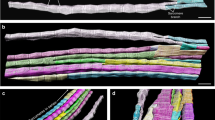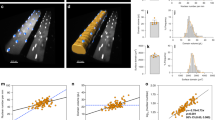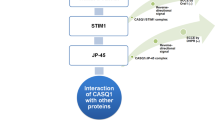Abstract
THE functions of the sarcolemma of skeletal muscle are still uncertain, because of our lack of knowledge of its structure and detailed distribution over the entire surface of the muscle cell. Most of our knowledge is derived from electron microscope investigations and the sarcolemma is regarded as a semi-permeable unit membrane about 100 Å thick, which directly encloses the contents of the cell. This membrane is probably bimolecular and lipoprotein in character, and similar to that which is thought to invest most animal cells and many of their cytoplasmic organelles. Immediately external to the sarcolemma is a layer about 500 Å thick; this is an extracellular deposition of material of moderate density (the so-called basement membrane1) which gradually diminishes in density as it extends from the sarcolemma into extracellular space and merges with the ground substance of the endomysial connective tissue. Because of its extreme thinness, the sarcolemma is difficult to observe in its longitudinal section; on the other hand, its characteristic unit membrane structure can usually be recognized in transverse section and occasional thickenings and invaginations of the sarcolemma are known to occur1 at certain regions of the cell. However, using thin-section techniques it is not easy to follow the detailed variations in its course over large areas of the cell surface. For structural investigations of this type the surface replication methods, such as the layer-stripping method developed by Reed and Rudall, are probably far more useful, as the various levels exposed in the tissue may be examined over wide areas2. Early investigations using the layer-stripping method revealed the sarcolemma as a continuous elastic sheet, capable of accommodating itself to the structures it encloses, since it often bears undulations corresponding to the striations of the myofibrils3.
This is a preview of subscription content, access via your institution
Access options
Subscribe to this journal
Receive 51 print issues and online access
$199.00 per year
only $3.90 per issue
Buy this article
- Purchase on Springer Link
- Instant access to full article PDF
Prices may be subject to local taxes which are calculated during checkout
Similar content being viewed by others
References
Bennett, H. S., in The Structure and Function of Muscle, edit. by Bourne, G. H. (Academic Press, London, 1960).
Reed, R., and Rudall, K. M., Biochim, Biophys. Acta, 2, 7 (1948).
Reed, R., and Rudall, K. M., Biochim. Biophys. Acta, 2, 19 (1948).
Huxley, A. F., and Taylor, R. E., J. Physiol. London, 130, 49 (1955).
Walls, E. W., in The Structure and Function of Muscle, edit. by Bourne, G.H (Academic Press, London, 1960).
Author information
Authors and Affiliations
Rights and permissions
About this article
Cite this article
REED, R., HOUSTON, T. & TODD, P. Structure and Function of the Sarcolemma of Skeletal Muscle. Nature 211, 534–536 (1966). https://doi.org/10.1038/211534b0
Issue Date:
DOI: https://doi.org/10.1038/211534b0
This article is cited by
-
In vitro dose effect relationships of actinium-225- and lutetium-177-labeled PSMA-I&T
European Journal of Nuclear Medicine and Molecular Imaging (2022)
Comments
By submitting a comment you agree to abide by our Terms and Community Guidelines. If you find something abusive or that does not comply with our terms or guidelines please flag it as inappropriate.



